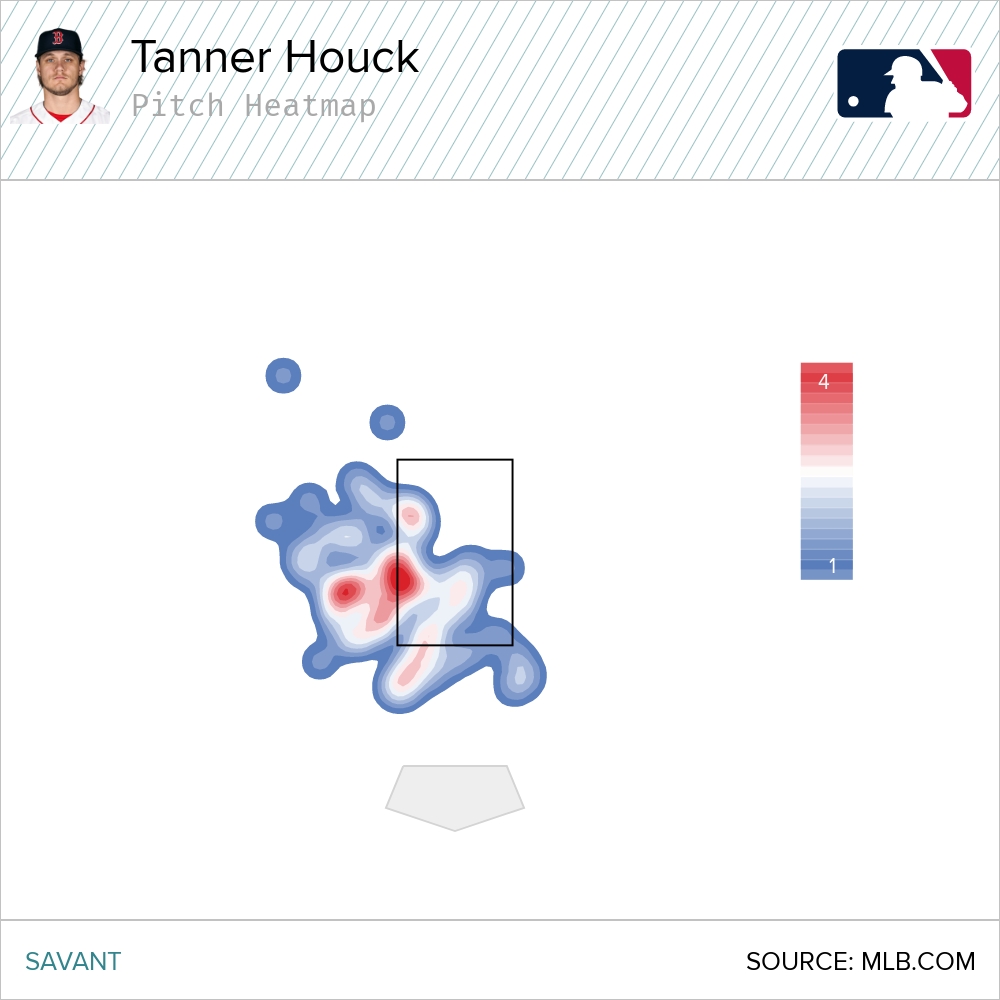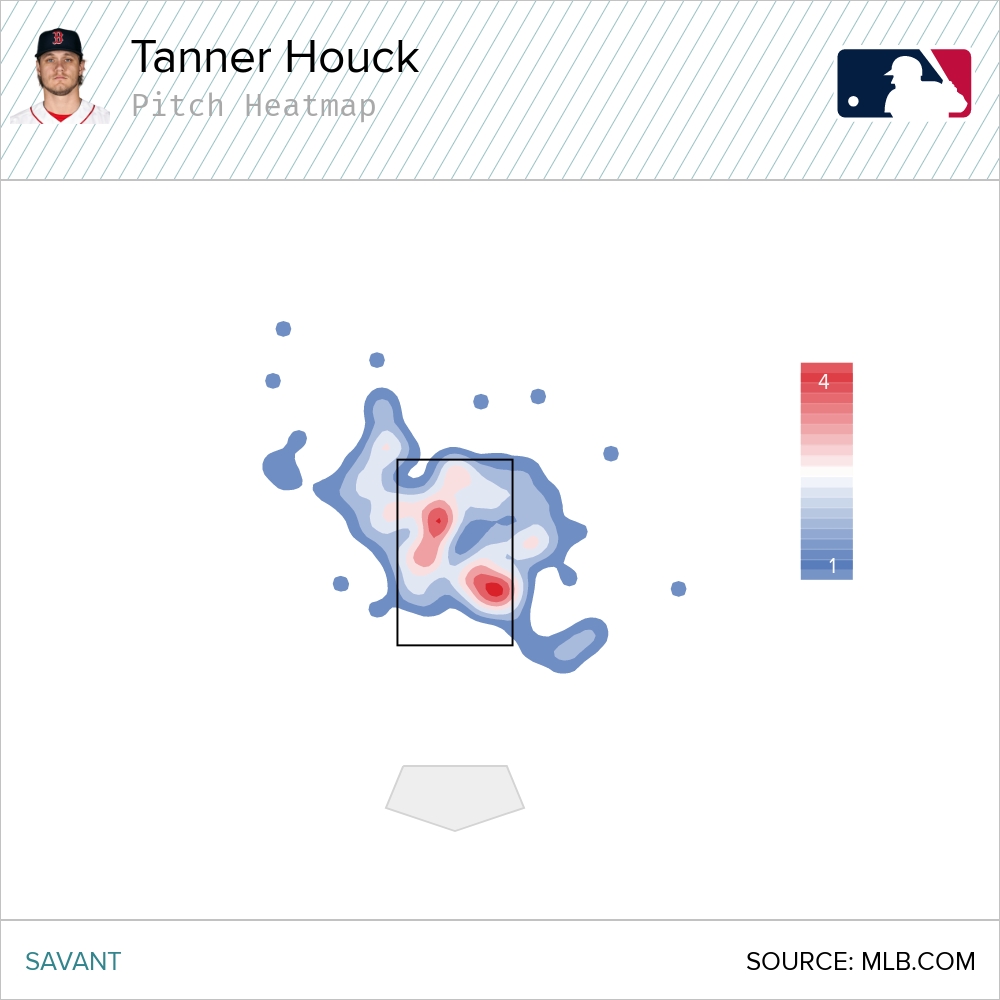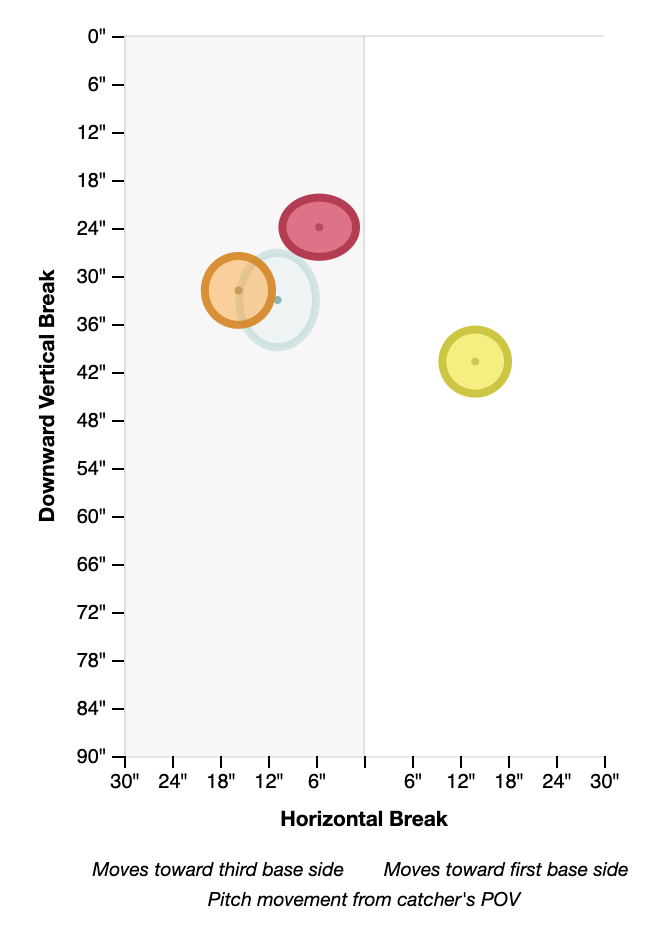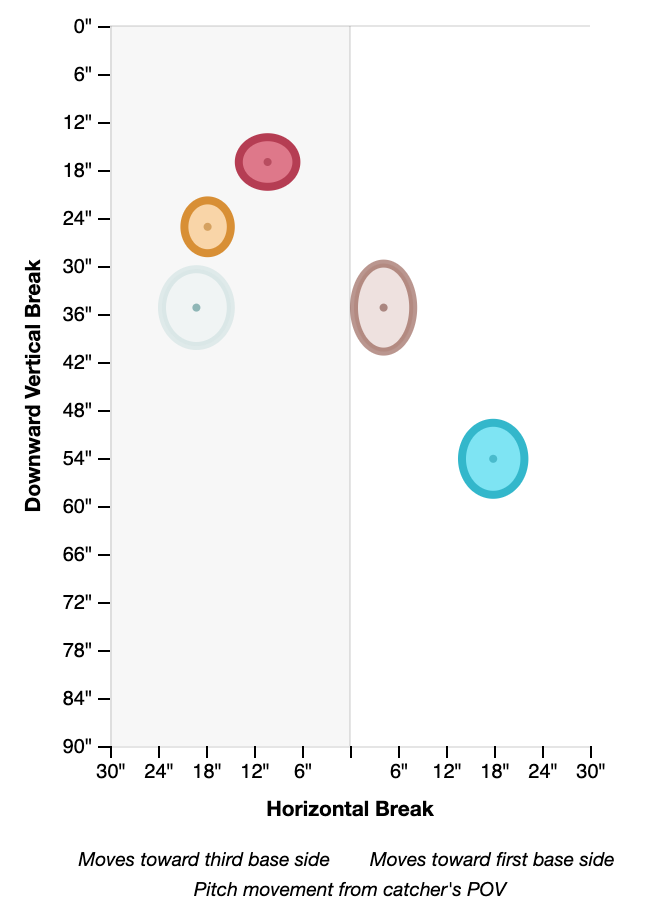The year 2020 was a tough one for Red Sox fans. After all the negative noise from the Mookie Betts trade and a last-place finish in the AL East, there wasn’t much cause for celebration in Beantown. It wasn’t all bad news, though; a few bright spots did show up in the form of first-year players Bobby Dalbec and Tanner Houck.
While Dalbec is interesting in his own right, Houck caught my attention after he won our Nastiest Pitch of 2020 Tournament. Seeing it myself, I understood why PL readers—and seemingly some of his family—voted the pitch to take the whole thing down.
This pitch gave rise to a curiosity that led me down a rabbit hole regarding Houck’s full repertoire, and what I found was a lot of stuff that should give Red Sox fans something to be excited about in 2021 and beyond.
Scratching the Surface
It needs to be stated upfront that Houck’s big-league portfolio is limited at this point, with only three starts in his first shot of espresso after splitting time between Double-A Portland and Triple-A Pawtucket in 2019. Regardless, the three starts yielded some admirable results:
| Date – Opponent | IP | Hits | Runs | ER | BB | K |
|---|---|---|---|---|---|---|
| 9/15/2020 – @MIA | 5.0 | 2 | 0 | 0 | 3 | 7 |
| 9/20/2020 – NYY | 6.0 | 1 | 1 | 0 | 3 | 4 |
| 9/26/2020 – @ATL | 6.0 | 3 | 1 | 1 | 3 | 10 |
Across 17 innings in 2020, Houck only gave up a single earned run to the Braves on a home run to Dansby Swanson, and finished with a 0.53 ERA, 0.88 WHIP, and 17 K to 9 BB. Aside from a 4.76 BB/9, the numbers look pretty good; but how did he utilize his repertoire to find this success? Let’s take a look pitch by pitch.
Slider
Houck’s bread and butter put-away pitch is his Slider. Here is the GIF of the pitch that won the Nastiest Pitch Tournament around a month ago:
Just pure filth. According to Alex Chamberlain’s Pitch Leaderboard, he used it to fool batters frequently, accruing a massive 38.3% CSW on the pitch, good for the 15th best slider among starters in 2020. He also managed an impressive 71.4% put-away rate, which ranked third amongst all starters. Here’s another taste:
Tanner Houck, Wicked 85mph Back Foot Slider…and Sword. ⚔️ pic.twitter.com/0TiGfDTDjT
— Rob Friedman (@PitchingNinja) September 15, 2020
Watching all his starts—and yes, I looked at every pitch he threw in 2020—he shows great feel for the pitch when on the mound. My only concern is that his control with the pitch leaves a bit to be desired, as it only managed a 33% zone rate. When he does get it over the plate, he collects an impressive amount of called strikes—he managed the third-best Called-Strike% on all sliders in the zone amongst starters in 2020.
Long story made short; The slider is his best pitch by a mile. If he can get it over the plate more, it could get even better in 2021 and beyond. It’s something to keep an eye on.
Sinker
As Houck spoke at length about in an interview with David Laurila over at Fangraphs, at the beginning of 2018 the Red Sox organization wanted him to move away from throwing his sinker and focus on wielding a more four-seam-heavy repertoire. That turned out to be a bad idea, as he ended up getting knocked around in the first half of the season in the Advanced-A Carolina League.
They reversed course in the middle of the season and essentially told him, “Throw what you know.” The turnaround was almost instant. After starting the 2019 season in Double-A, Houck finished with Triple-A Pawtucket, reimplementing himself as a top prospect in the Red Sox system.
Watching live tape of his sinker, the movement profile is arguably more wicked than his slider. Here is an excellent overlay featuring both pitches, from Rob Friedman (@PitchingNinja) on Twitter:
Tanner Houck, 93mph Two Seamer (foul) and 82mph Slider (backwards K), Individual Pitches + Overlay. pic.twitter.com/T3c8UKFTPu
— Rob Friedman (@PitchingNinja) September 16, 2020
After doing some digging, that crazy movement can likely be explained by some recent research by Driveline regarding Seam-Shifted Wake, written up by R&D Analytics Intern Christian Hook.
For those of you who haven’t read up on Seam-Shifted Wake, it essentially attempts to address how a baseball’s seams affect its flight path. While some jumps need to be made, the folks at Driveline theorize that a metric can be applied to this effect in three steps:
- Using the movement profile of a pitch to assign what they call an Inferred Spin Axis;
- Examining Hawk-eye data to determine true spin direction, also known as Observed Spin Axis;
- Calculating the gap between those two axes, resulting in a metric they have deemed 2D Axis Deviation.
Basically, the larger the deviation (to the positive), the greater the effect they theorize Seam-Shifted Wake is having on a pitch’s movement. When Driveline looked at all pitchers who threw at least 50 sinkers in 2020, Houck had the greatest 2D Axis Deviation, beating out other notable sinker-ballers like Lance Lynn, Kyle Hendricks, and Max Fried, among others. It was at this point that Houck fully garnered my attention.
His results with the sinker in 2020 reflected this finding. Like most sinkers, it did not—and will not—collect a ton of swing and miss (7.7% SwStr), but it only resulted in a single hard-hit ball (14.3% Hard-Hit) and collected a 71.4% ground-ball rate in his three starts. That will play!
One issue that Houck may have with the sinker is his seeming inability to throw it to the glove side. As he stated in the Fangraphs interview, there is a lot of risk in throwing a glove side sinker, since it is very easy to leave it over the middle of the plate if you miss your spot. When you look at his sinker heatmap from Savant, it is clear this concern still exists:

Living exclusively in the lower part of the zone on his arm side, it seems Houck fails to take full advantage of the pitch; honestly, there’s not a whole lot he can do about that. It is naturally going to live there due to its extreme movement profile.
Keeping this in mind, it would be nice to see him develop the confidence to throw it to his glove side with a bit more frequency to steal an occasional strike. I would also love to see an uptick in his usage of the pitch from the 24.5% clip we saw in 2020, considering how effective it was.
Four-Seam Fastball
Even with all my fanfare regarding his move back to his sinker over a four-seamer in Double-A, Houck still utilized his four-seamer more often than any other pitch in 2020, sitting at 37% usage over his three starts. Still maintaining some arm-side run and sink due to his low arm angle on release, the four-seamer takes a straighter flight path and averages about two ticks more velocity than his sinker.
The pitch wasn’t stellar in 2020, only netting a 21.4% CSW, but it also didn’t get knocked around too badly, which is a positive. He also was clearly more confident in throwing this pitch to his glove-side, as evidenced by his heatmap:

That’s a good thing! But in its current state, there isn’t that much else about the pitch that wows me. I’d say it’s currently an average to below-average offering at best because the movement profile is similar to his sinker, just… less spectacular. The only real difference is seam orientation on release, as the spin axis is essentially identical to his sinker.
I think it is a necessary evil to have the four-seam in his repertoire, but the lack of rise on the pitch—ranked dead last in the league (min. 50 thrown) according to Savant—makes me think that he won’t be able to elevate the pitch in the zone with great results. I suspect he could get beat up on this one a bit.
Personally, I would love to see him use the pitch a bit less, to the point that there is some parity between it and his sinker.
Finding the Missing Pieces
While the four-seam is here to stay and has its role, Houck has been searching for another reliable offering for a few years now. He has tried a few different changeups, none of which have stuck around for long. The most recent attempt is a splitter that he picked up in 2019, but the pitch only showed up eight times (3% usage) in his three starts in 2020. Not much to form an opinion on, but I’ll try.
Remember how my issue with the four-seam is the movement profile being too similar to the sinker? Well, the splitter is even more akin to it. Check out Houck’s current arsenal below, where the four-seam is in red, the sinker is in orange, and the splitter is in light blue:

The splitter (87.1 mph) was four ticks slower on average than the sinker (90.9), and occasionally got a bit more vertical break, but there’s enough overlap that it could almost just look like he took some velo off his sinker. That’s not going to be a cause for success, and he needs to create more separation there.
A guy with a similar repertoire to look at as a model for success would be Charlie Morton. Take a look at the separation Morton is able to to get on the same pitches; four-seam in red, sinker in orange, splitter in light blue:

There is a clear separation between each of his offerings. Not just that, but Morton also manages to put an average of seven full ticks of velocity between his splitter (85.8) and his sinker (92.7).
It seems like Houck was set on working on the splitter in the offseason, so let’s hope he’s been able to make some progress. That said, I don’t think he’ll be figuring this out overnight, and he’s likely a year or two off from really utilizing the pitch to its full effect.
Taking another cue from Morton, I’d love to see Houck eventually add a cutter to his repertoire (represented in the above graph in brown). There’s precedent when it comes to sinkerballers adding the pitch to their repertoire; most recently with Lance McCullers, who turned to the pitch in 2020 to some exciting results. Yankees reliever Adam Ottavino—who has an eerily similar release point as Houck—also added the offering in 2015 and has found some success in limited use.
This likely isn’t a pitch that is going to supplant any of his main three offerings anytime soon, but the name of the game is creating greater deviations within his repertoire’s movement profile. If he can continue to develop these other secondaries with that in mind, it is going to make Houck a more deceptive and effective pitcher.
Conclusion
While he’s an unfinished product that could do with some polishing, Tanner Houck has two really great offerings that act as a foundation for growth and success moving forward. Though it remains to be seen if he’ll stick in the starting lineup in Boston in the long-term, he’s got a great opportunity in front of him right now.
Even after the Martín Pérez signing over the weekend, Fangraphs’ RosterResource tool has Houck listed as SP3, which sets him up for two straight starts against the Orioles to kick off the season. I’m excited to see how he can parlay his short-term success in 2020 and two solid matchups to begin the year into a successful 2021 campaign.
Photos by David John Griffin/Icon Sportswire | Adapted by Michael Packard (@designsbypack on Twitter & IG)
Research Assistance – Chris Weber (@Shwebsi) and Michael Ajeto (@dysthymikey)

